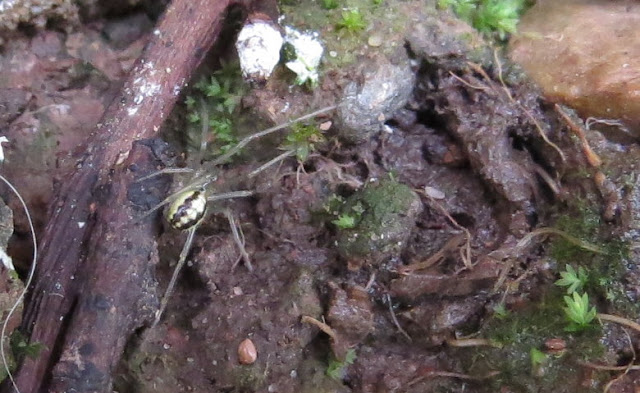Starting with amphibions, the Common Frog is the only one to have been seen in our garden so far. As we have no pond, its remarkable that they live here, but they do.
 |
| Tree Bumblebee |
 |
| Ashy Mining Bee |
 |
| Red Mason Bee |
 |
| Blue Mason Bee |
 |
| Western Honey Bee |
 |
| Red-tailed Bumblebee - worker |
 |
| Willughby's Leafcutter Bee - 2 July 2017 |
 |
| Buff-tailed Bumblebee - queen |
 |
| Grey-patched Mining Bee - 2 Apr 2017 |
 |
| Hairy-footed Flower Bee - Apr 6 2017 |
 |
Probably a Buff-tailed Bumblebee - worker
|
 |
| Common Wasp - deceased |
 |
| Vestal Cuckoo Bee |
 |
| Common Carder Bee |
 |
| Tawny Mining Bee |
Some of these bees may change identity if I become convinced I have made a mistake.
There are hundreds of species of beetles in the UK and I don't know anything about any of them. However, one species insists on invading our house every year, and I have concluded it is the Mealworm Beetle.
 |
| Telebrio molitor - Mealworm Beetle |
 |
| Ledra aurita |
 |
| Froghopper |
 |
| Oedemera nobilis - May 2017 |
 |
| Pyrochroa serraticornis - May 2017 |
 |
| Donacia vulgaris - May 2017 |
On a par with beetles, bugs can also be tricky. However, Ledra aurita is so weird-looking that I think it can be identified with some confidence.
There are a band of natural history enthusiasts who specialise in an incredibly difficult field. They are the dipterists or fly watchers. Well I take my hat off to them because to get down to species level it seems a microscope and a dead subject is generally required. As I have neither, I am left to snap away and hope I get them nearly right.
 |
| Greenbottle (no idea which species of Greenbottle) |
 |
| Phaonia tuguriorum |
 |
| Tiger Cranefly |
 |
Cranefly - Either Tipula oleracea or Tipula paludosa
|
 |
| Nephrotoma flavipalpis |
 |
| Tipula oleracea (female) - I think - 22 Aug 2016 |
 |
| Nephrotoma appendiculata - May 2017 |
 |
| Tipula luna - May 2017 |
 |
| Caddis Fly sp 19/04/2018 |
 |
| Caddis Fly sp - 19/04/2018 |
Moving on to ever more tricky beasts, we come to the ants. We spend most of our time trying to keep them out of the house, and photographing them seems next to impossible, so my only representative is this one. The identification may well be incorrect.
 |
| Black Garden Ant |
The next group are bugs, and particularly Shieldbugs, which are rather spectacular.
 |
| Hawthorn Shieldbug |
Mammals on the other hand are a whole lot easier. The only one I have a photograph of in the garden is this one.
 |
| Grey Squirrel |
From the very easy to the very difficult, in fact impossible. Slugs and Snails are obviously easy to photograph, but when I started to research what species I was looking at I came up against such statements as "one of several identical species, only safely separated by examination of their genitalia". Well that's not about to happen so here are some random slugs.
 |
| Arian ater - possibly |
 |
| A fat brown one |
 |
| Possibly a Field Slug |
 |
| A grey one |
 |
| An orange one, possibly the orange form of Arion ater |
 |
| Yellow Slug (that really is its name) |
 |
| This might be a Tree Slug |
 |
| Possibly Black-lipped Snail |
 |
| Possibly a White-lipped Snail |
 |
| Garden Snail |
Finally we come to the arachnids, another group about which I know absolutely nothing.
 |
| Crab Spider sp |
 |
| No idea |
 |
| Pass |
 |
| Spiderlings |
 |
| Daddy Longlegs Spider with its lunch |
 |
| Tetragnytha sp - an Orb-Web Spider - May 2017 |
Although we have clearly reached the end of my knowledge, that doesn't mean I am giving up. I am hoping to add some names to the species I have not yet identified in due course.
I am now starting a new section called random insects. First up is the Common Earwig.
 |
| Common Earwig - Forficula auricularia |



























































No comments:
Post a Comment